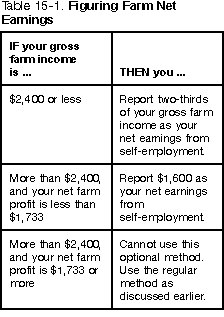Methods for Figuring Net EarningsThere are three ways to figure your net earnings from self-employment.
You must use the regular method unless you are eligible to use one or both of the optional methods. See Figure 15-1.
Figure 15–1. Can I Use the Optional Methods? Why use an optional method? You may want to use the optional methods (discussed later) when you have a loss or a small net profit and any one of the following applies.
Effects of using an optional method. Using an optional method could increase your SE tax. Paying more SE tax could result in your getting higher benefits when you retire. If you use either or both optional methods, you must figure and pay the SE tax due under these methods even if you would have had a smaller tax or no tax using the regular method. The optional methods are used only to figure your SE tax. To figure your income tax, include your actual earnings in gross income, regardless of which method you use to determine SE tax. Regular MethodMultiply your total earnings subject to SE tax by 92.35% (.9235) to get your net earnings under the regular method. See Short Schedule SE, line 4, or Long Schedule SE, line 4a. Farm Optional MethodUse the farm optional method only for earnings from a farming business. You can use this method if you meet either of the following tests.
Figuring farm net earnings. If you meet either of the two tests explained earlier, use the following table to figure your net earnings from self-employment under the farm optional method. Gross farm income. Your gross farm income is the total of the amounts from:
Net farm profit. Net farm profit generally is the total of the amounts from:
Social security credits. Since two-thirds of $2,400 is $1,600, this counts for one credit ($1,600 ÷ $830) for social security coverage in 2001. You cannot use the full amount of your gross income to determine credits when you are figuring the SE tax on only two-thirds of that amount. Optional earnings less than actual earnings. If your farm net earnings are less than your actual net earnings, you can still use the farm optional method. Your actual net earnings are your net earnings figured using the regular method explained, earlier. Example. Your actual net earnings from self-employment are $425 and your net earnings figured under the farm optional method are $390. You owe no SE tax if you use the optional method, because your net earnings under the farm optional method are below $400. Two or more farms. If you operate your own farm and are also a partner in a farm partnership, or in any way have gross farm income from more than one farm, you must add your farm income from all farming sources to get your total earnings subject to SE tax. If you use the farm optional method, you must add all gross income from farming to make the $2,400 test. Example. Your gross income from your own farm is $600 and your distributive share of the gross income from a farm partnership is $900. Since your gross income from farming is less than $2,400 ($1,500), your earnings subject to SE tax under the farm optional method are $1,000 ( 2/3 × $1,500). Nonfarm Optional MethodThis is an optional method available for determining net earnings from nonfarm self-employment, much like the farm optional method. If you are also engaged in a nonfarm business, you may be able to use this method to compute your earnings subject to SE tax from your nonfarm business. You can use this method even if you do not use the farm optional method for determining your earnings subject to SE tax and even if you have a net loss from your nonfarm business. For more information about the nonfarm optional method, see Publication 533.
Using Both Optional MethodsIf you use both optional methods, you must add together the net earnings figured under each method to arrive at your total net earnings from self-employment. You can report less than your total actual net earnings from farm and nonfarm self-employment. If you use both optional methods, you cannot report more than $1,600 of your combined net earnings from self-employment. |

 You cannot combine farming income with nonfarm income from
self-employment to figure your earnings subject to SE tax under either
of the optional methods.
You cannot combine farming income with nonfarm income from
self-employment to figure your earnings subject to SE tax under either
of the optional methods.